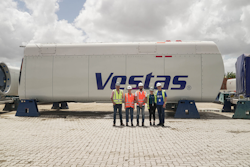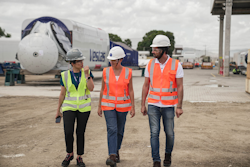Wind turbines are ageing, what’s next?
Wind power, like any other renewable is clean, increasingly cheaper and emission-free, but for it to be considered truly green, it is important to evaluate its end-of-life environmental impact. As the first commercial wind turbines came online in the mid to late ‘90s, they are now reaching the end of their operational life and need to be decommissioned. This raises the question of what to do with their waste. Our energy expert and onboard scientist Beatrice Cordiano tells us more about this.
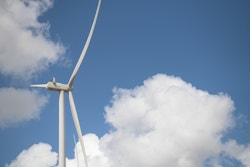
Windfarm in Brazil
As of 2022, the total capacity of all wind turbines worldwide has exceeded 906 GW, enough to provide more than 7% of the global electricity generation. Wind turbines are growing taller, bigger and more powerful, offering the possibility of reliable and abundant energy.
Wind turbines do not turn forever, they are engineered to last at least 20 years and their lifetime can be increased with if they are properly maintained. They run about 7500 hours per year, 150 000 hours and even more during their lifespan and, sooner or later, the constant exposure to wind and weather will bring evident effects, that’s when they will need to be taken out of use. That is what is happening for the initial wave of wind turbine installations – which, in Europe, traces back to the 1990s, mainly in Germany, Denmark and Spain – that today are approaching the age of retirement.
Once it reaches the end of its lifecycle, a wind turbine presents three possible courses of action: extend its operations by three to five years, undertake a repowering operation - the replacement of old turbines with more efficient models, making it possible to increase the output of the wind farm without requiring additional land- or, if none of these alternatives proves viable, dismantle the park. By 2030, about 50 000 wind turbines are expected to reach or exceed 20 years of life in Europe, and from 2030 onwards, a further 5 700 per year will be added to the dismantling pipe as a result of repowering. One question arises: what will happen to this ageing and obsolete stock?
Contrary to common belief, wind turbines are recyclable
There is a misconception that wind turbines are environmentally harmful because of their components and that, for this reason, they are impossible to recycle. This is wrong: about 96% of a wind turbine is recyclable. To understand this, you just need to look at the composition of such a technology.
Shell, shafts, gearing and electrical components, a wind turbine is made up of more than 8000 parts. But to make it simple we can divide it in four parts, each with specific functions and therefore materials:
- The foundations, buried in the ground, are made of concrete and scrap metal.
- The tower, which needs to support the nacelle and provides access to it, is essentially made of steel.
- Going up we find the nacelle, which houses the system to convert the wind’s mechanical energy into electricity and is therefore mainly constituted by electrical components.
- And finally, the rotor – hub and blades – made of a polymer resin reinforced with fiberglass and occasionally carbon fibre.
If we relate these materials to the tonnage of the wind turbine, we find that almost 90% of it is steel and cement, 6% is fiberglass, only 3% are polymers and the rest are metals and electronic materials. Most of it is therefore fully recyclable. In 2021 the recycling rate of wind turbines in France, excluding the blades, approached 98% (96% with the blades).
Blades: the Achilles’ heel of wind energy
While the concrete can be crushed, sorted and recycled as aggregate for other types of concrete, in particular for other wind turbines, or as fill, and steel can be recycled over and over without any loss of property, that is not the case for the blades, which - it is a well-known fact - at present are the hard nut of wind turbines recycling. Now, the problem with blades is the way they are built. Fiberglass is composed of fine strands of plastic and glass, which makes them hard and costly to recycle.
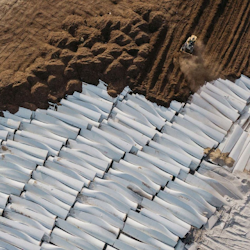
Bloomberg Green
According to estimates, 1 GW is expected to be dismantled annually in France by 2025, which means 3000 to 15000 tonnes of composite materials per year. The issue of the recycling of composite materials is not unique to the wind power industry, the same materials being used by the automotive, shipping and leisure industries for aeronautical parts, boats’ hulls and even skis, but it is often used to discredit the sustainability of this renewable energy. Although blades are inert and do not produce toxic emissions - being therefore quite safe for landfills - their uncontrolled disposal remains a huge waste of resources that moves away from sustainability and circularity criteria. There is no denying that a lot of first-generation blades end up in landfills - but not in Europe, where burying wind turbine blades is strictly prohibited - however that’s not the case for all of them.
Reuse, recycle, build smarter
Manufacturers and operators are focusing on new approaches, trying to find ways to separate the polymer matrix from the reinforcing fibres to recover and reuse the materials, or rebuild new blades using recyclable materials. Wind blades can thus be entirely repurposed as structural elements such as playgrounds, bike shed, noise barriers or parts of civil engineering projects. They can be recycled in a mechanical way, shredded, and often reused as filler material in buildings: a process Veolia, the French resource management company, masters using crushed blade materials as an ingredient for cement production. They can be treated thermally, incinerated, and revalorised as fuel for energy production, and - in few cases - they can also undergo a chemical process where the fibres are separated from the resins by means of solvents and thermal processes.
That is what Vestas, the Danish wind turbine manufacturer, is working on, testing a cutting-edge technology which breaks down blades in a liquid using inexpensive, non-toxic, and readily available chemicals, which allows to produce high quality materials using little energy.
Other initiatives are looking at modifying the materials used to make turbines, with the aim of designing a new generation of blades made from thermoplastics that are either biodegradable or can be reconstituted at the end of their useful life, making the blades more sustainable to manufacture and easier to recycle. That is the case of the first fully recyclable blades that the ZEBRA (Zero wastE Blade ReseArch) consortium has worked on, producing them in LM Wind Power’s Ponferrada factory in Spain, before testing and marketing them in Denmark.
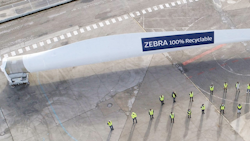
Wind Power
There is always room for improvement, particularly by keeping working on the eco-design of components. This 100% recyclable blade is an important step and a promising breakthrough that can help achieve an increased sustainability in the wind energy sector, while waiting to create a highly efficient supply chain capable of recycling and upgrading all components.
Needless to say, even if today the wind turbines current form may not be perfect, their positive environmental impact far outweighs the negative ones on the overall life cycle.










